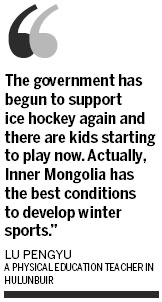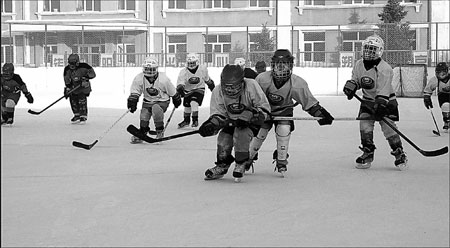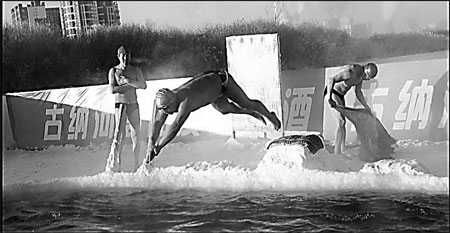Never too cold to play
Updated: 2013-02-15 07:57
By Tang Zhe (China Daily)
|
||||||||
|
Children in Manzhouli participate in ice hockey practice at Manzhouli No 5 Middle School during winter vacation. The city is building up regular sports exchanges with neighboring Russia to improve the competitive level of its local teams. Provided to China Daily |
|
Winter swimming enthusiasts take the plunge in Yimin River of Hailar in temperatures below -30 C in January. A group of 80 people, mostly elderly, regularly swim in the frigid waters. Provided to China Daily |

In parts of China where the temperature can drop far below freezing for much of the year, athletes find plenty of creative ways to stay active, Tang Zhe reports from Hulunbuir, Inner Mongolia autonomous region.
There are ways to deal with the cold. Boasting splendid scenery and one of the world's most magnificent grasslands, Hulunbuir attracts more than 10 million tourists each summer.
But all that changes with the arrival of seven months of winter, as the seemingly boundless land turns a monotonous tone of white and temperatures sink to -40 C.
Still, those bitterly cold days turn out to be the best time for sports enthusiasts, who have discovered great fun is to be had in the ice and snow in all manner of winter sports.
Winter sports revival ongoing in Hulunbuir
Located in the northeast of the Inner Mongolia autonomous region, Hulunbuir has a long tradition of winter sports dating back to the 1970s, especially in speed skating and ice hockey. Unfortunately, the region has dropped its support of its local teams and sports in the region have suffered a major decline for more than a decade.
Lu Peiyu is one of those athletes who has seen the best and worst of ice hockey in the area. The 59-year-old physical-education teacher began playing ice hockey in primary school and encouraged talented children to play for the provincial team in the 1980s.
Every winter, he and his friends gather from different parts of Hulunbuir to play. They form four teams at each gathering and normally attract about 40 players.
China used to have two ice hockey leagues, and there were more than 20 professional teams in the second-tier league at its peak. Now that the sport has been discarded from the State-supported system, it has experienced a drastic decline in popularity and almost all those playing in Hulunbuir now are 40 years of age or older.
"Ice hockey has been neglected in Inner Mongolia for almost 20 years. There still isn't a team or league in the autonomous region, so we just play together as a hobby," Lu said after a game in Zalantun, a division of Hulunbuir prefecture.
However, he is glad to see the government again paying attention to the sport in recent times.
"The government has begun to support ice hockey again and there are kids starting to play now. Actually, Inner Mongolia has the best conditions to develop winter sports," Lu said. "I have played ice hockey all my life and I am very excited to see the sport coming back."
The shortage of indoor stadiums is the biggest obstacle to the region's development of winter sports.
Yang Xiaodong, president of the Zalantun Winter Sports Association, said the city does not lack passion for sports, but desperately needs a stadium to use in summer when there is no ice.
The association, founded in 2008, now has more than 30 hockey players and nearly 80 speed skaters on its books.
"We grow up in an extremely cold area and these sports give us lots of happiness," said the 53-year-old. "But the biggest obstacle to popularizing sports is the lack of an indoor stadium in Zalantun due to monetary difficulties. Otherwise, all the residents would be very grateful."
Winter swimming a calling card for Hailar
While most people are reluctant to leave their warm houses in winter, a group of elderly people in Hailar, the administrative center of Hulunbuir, "enjoy" themselves in Yimin River, where the temperature is often -30 C.
Xie Zhansheng is one of the oldest among the winter swimming enthusiasts.
The 83-year-old, who swam in the summer after his retirement, decided to give ice-water swimming a try while watching others swim in the river during winter 16 years ago.
"I had a try and felt very comfortable, so I continued," Xie said. "After three years, migraines that had plagued me for two decades disappeared, my constitution became better and I feel in an all-around better mood."
According to Yun Feng, president of the Hailar Winter Swimming Association, the chilly sport stimulates circulation, improves the body's immune system and is a benefit to overall health. It is especially popular among the elderly and retired.
Every winter, they carve a pool out of the ice from Yimin River and swim on a daily basis.
Since the self-supported association was founded in 1996, its membership has grown from a dozen to 80. It could have exceed the number years ago if not restricted by the limited space of the association's locker room, a 40-square-meter room bought by Yun near the river, which can't hold more people than that at any given time.
"The special aspect of Hailar is, compared with other areas of the country, it has the longest period for winter swimming thanks to its high latitude," Yun said.
"After many years of experience, we found this place perfect to promote winter swimming. People from different backgrounds and ethnic groups come together and benefit from exercising."
As winter swimming in Hailar grows in fame, the local government is becoming more active in organizing competitions as part of its promotion of winter tourism.
Hailar invited winter swimmers from northern cities to compete there last February, and held a national event in December, which included 14 teams from seven provinces.
"Those from the south said this is the real winter swimming - it's quite different from what it feels in the south, and they found it quite exciting," Yun said.
Sun Wei, deputy head of Hailar government, said the coldest winter swimming in China has become the district's calling card.
"Though not every resident participates in winter swimming, the activity, with its distinctiveness, has become a brand name for Hailar's mass exercises and winter tourism," she said.
Manzhouli is out front in sports exchange
Located on the border of China and Russia, Manzhouli, the country's biggest land port, not only connects businesses from the neighboring countries, but also exhibits a strong blend of cultural exchange.
The two sides' connection in sports can be traced back 57 years to when the Soviet Union helped the city build its first stadium in 1956.
The wooden stadium is supported by 18 wooden pillars from the Chita state of Russia. It remains in fine working condition and often sees Russians play table tennis at the sturdy venue.
Influenced by Russia's strong sporting culture, the border city opens all of its 20 venues for free during the winter to enable residents to participate in sports and exercises.
The sports exchange between the two countries continues to grow year by year.
Xu Wei, deputy director of the Manzhouli sports bureau, said Manzhouli linked up with Russia in nine sports in 2012, including rhythmic gymnastics, ice hockey, speed skating and tai chi.
"This city is different from others because Manzhouli's special attention to sports is largely a result of Russia's influence," Xu said. "The Russians are superior - especially in rhythmic gymnastics. Their kids come to perform here twice a year, we provide them with free venues, and organize the local children to watch and learn from them.
"We invited three Russian ice hockey teams to compete with four domestic teams in December, and our young players have improved a lot through the tournament."
The Russians, on the contrary, are greatly interested in China's traditional martial art of tai chi.
Liu Xiuying, chief of Manzhouli's tai chi association, said she was overwhelmed by the Russians' passion for the sport when she led a team to perform at Russia's international gymnastic festival in 2010.
"I didn't expect them to be so obsessed with traditional Chinese culture," Liu said. "The media in Russia had a whole week of coverage of our performances, and from 2011 the government of Chita started to encourage its staff to practice tai chi and sent them to Manzhouli as part of an exchange program that same year.
"Based on the success of tai chi, we are now trying to promote body-building qigong in Russia. It has developed into a regular program between the two countries, and the Russians are making fast progress."
According to Xu, Manzhouli, with its geographical advantage and sound sporting facilities, is expecting to build itself as an exchange platform for Chinese athletes and their Russian counterparts.
"We are planning to invite winter sports teams and children from other areas of China to compete and communicate with the Russians in Manzhouli," Xu said. "It will help improve our players' performances, boost cultural exchanges and also save the athletes money."
Contact the writer at tangzhe@chinadaily.com.cn
(China Daily 02/15/2013 page11)

 In Photos: 7.0-magnitude quake hits Sichuan
In Photos: 7.0-magnitude quake hits Sichuan
 Li Na on Time cover, makes influential 100 list
Li Na on Time cover, makes influential 100 list
 FBI releases photos of 2 Boston bombings suspects
FBI releases photos of 2 Boston bombings suspects
 World's wackiest hairstyles
World's wackiest hairstyles
 Sandstorms strike Northwest China
Sandstorms strike Northwest China
 Never-seen photos of Madonna on display
Never-seen photos of Madonna on display
 H7N9 outbreak linked to waterfowl migration
H7N9 outbreak linked to waterfowl migration
 Dozens feared dead in Texas plant blast
Dozens feared dead in Texas plant blast
Most Viewed
Editor's Picks

|

|

|

|

|

|
Today's Top News
Live report: 7.0-magnitude quake hits Sichuan, heavy casualties feared
Boston suspect cornered on boat
Cross-talk artist helps to spread the word
'Green' awareness levels drop in Beijing
Palace Museum spruces up
First couple on Time's list of most influential
H7N9 flu transmission studied
Trading channels 'need to broaden'
US Weekly

|

|









